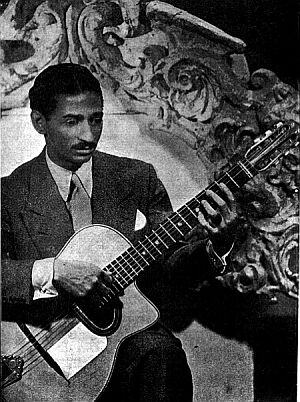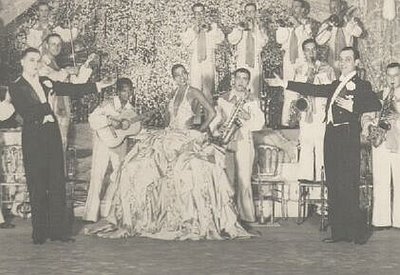
 I was just watching an interview with Nélida Fernando and she mentioned going to the club to hear Juan D'Arienzo and Oscar Alemán. I was curious if he was a singer or leader of an orquestra that I had never heard. So, I started doing some research and here is what I have found.
I was just watching an interview with Nélida Fernando and she mentioned going to the club to hear Juan D'Arienzo and Oscar Alemán. I was curious if he was a singer or leader of an orquestra that I had never heard. So, I started doing some research and here is what I have found.
Oscar Alemán was an Argentine jazz guitarist born in 1909. He was considered one of the greatest jazz guitarists of all time, on the same level with Django Reinhardt.
He came from a family of performers and musicians. His mother was of the Toba, a native Argentine people. As a child, he travelled to Brazil with his father. Shortly after this, tragedy struck, his mother died and his father committed suicide. He lived on the streets and at age 14 created a duo, Les Loups, with Gastón Bueno Lobos.
In 1926, they travelled to Buenos Aires. In December of 1927, they recorded their first 78, which included the tango "Hawianita" and the wonderful vals "Criollita." It is worth noting that on "Criollita," Lobo is playing a cavaquinho, which is a 4 string ukelele type of instrument, while Alemán is playing guitar.
In 1928, they record "La Cumparsita."
During this time, Alemán and Lobo also performed as part of Trio Victor for the Victor record label with violinist Elvino Vardaro. Here is their recording of "Recondita" from 1929. Alemán also played guitar for other Tango artists such as Rosita Quiroga. You can usually tell that it is him, because of the unique sound of his Hawaiian guitar.
I should mention that most of his music was Jazz and not Tango, the songs above are a very small portion of his work. In 1929, Alemán and Lobos travelled to Europe to support the dancer Harry Fleming. After the tour, Alemán stayed in Spain. He later travelled to Germany and France. In France, he discovered American jazz and met Josephine Baker. He ended up leading her orchestra, known as the "Baker Boys" at the Cafe de Paris. During his time in Europe, he also played with Louis Armstrong and Duke Ellington. When Germany invaded France, in 1940, he returned to Buenos Aires, Argentina.

Now is where we get back to what prompted me to do this research. Why was he mentioned in the same breath as D'Arienzo. It turns out that in the mid to late 1940s, Alemán's jazz groups used to play at clubs along with Juan D'Arienzo and these gigs were labelled as "Tango y Jazz." So, if I am understanding correctly, they would switch off playing sets. Back then, when you went to a club, you would hear tango, foxtrot, folk music, jazz, etc.
Here is an interesting video of Alemán playign at a club from a movie titled "El Idolo del Tango" from 1943. What I find interesting is that, it seems that one band or orchestra ends playing and he comes onto the stage and begins to play jazz/swing and the audience still dances with a tango like embrace. Then he gets off the stage and clearly begins dancing swing. So, when they are dancing tango type steps to the swing music, are they dancing alternative tango? ;-)
Again, the majority of his recording career, which spanned from 1927 to 1972, was almost all jazz. Here is a beautiful version of "Milonga Triste," from 1954.
As I mentioned at the beginning of this post, he is considered one of the greatest jazz guitarists, so here is his rendition of the classic "Sweet Georgia Brown." This is one of the best versions of this song that I have heard, you can hear his genius and that he really makes it his own.
He was friend with Django Reinhardt and supposedly he would fill in for Django when he livedi n Paris, when Django would not show up for shows. Here is what he had to say about Django, "I knew Django Reinhardt well. He used to say - jazz was gipsy - we often argued over that. I agree with many Americans I met in France who said he played very well but with too many gipsy tricks. He had very good technique for both hands, or rather one hand and a pick, because he always played with a pick. Not me, I play with my fingers. There are things you can't do with a pick - you can't strike the treble with two fingers and play something else on the bass string. - But I admired him and he was my friend. He was my greatest friend in France. We played together many times, just for ourselves. I used to go to his wagon, where he lived. I've slept and eaten there - and also played! He had three or four guitars. Django never asked anyone to go to his wagon, but he made an exception with me. I appreciated him, and I believe the feeling was mutual".
And a comment he made about the tango of Piazzolla, Troilo and Salgán:
"They are two different things. Piazzolla introduces a lot of jazz into tango, Troilo has a pure way of playing. It doesn’t mean he’s a better bandoneon player or a better musician. I regard Piazzolla as a great musician. Salgán is also greatly influenced by jazz, I love him, he’s got much musicality inside."
He died in Buenos Aires in 1980 at 71.
More Information:
Todo Tango
Tango Reporter
Wikipedia

